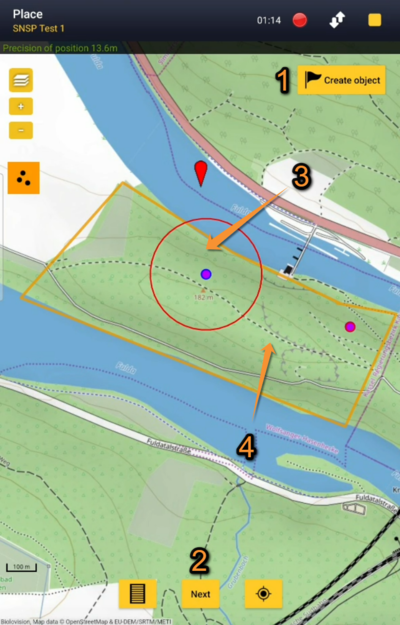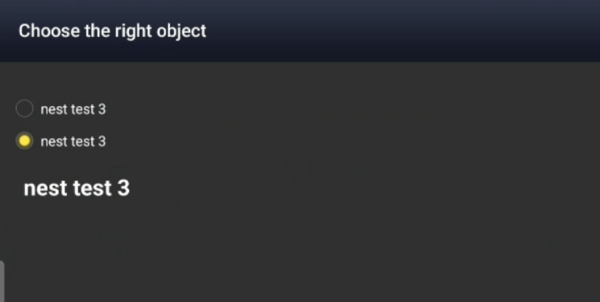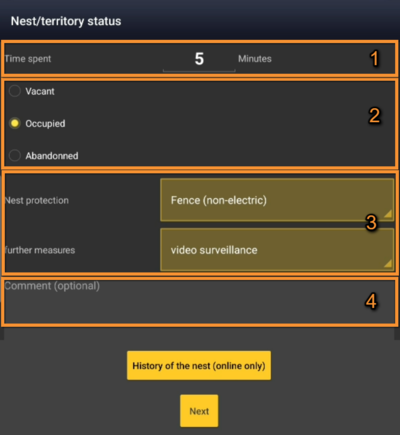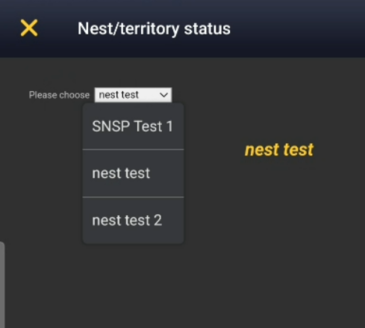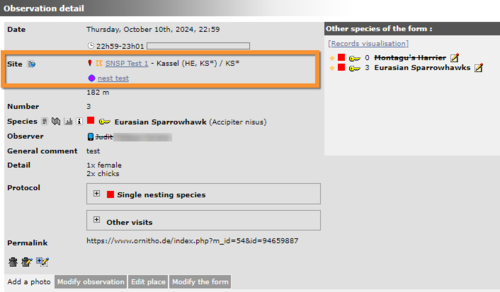SNSP (NL)
SNSP
Single nesting species
· Enter Single nesting species.
· Choose the site to survey, if more than one.
Open the menu as for Submitting records and choose Single nesting species (see image below).
Choose the site you want to count at as explained in wiki section Mobile interface > Protocols > Enter data.
SNSP Start of list
Enter general information before starting the count. Fields are protocol dependent and may change from country to country.
Visit wiki section Mobile interface > Protocols > Enter data > Start of list for details.
Click Next when done.
SNSP Entering records
Create nests and territories (objects) or enter observations associated to already created objects or not. The information required will vary depending if it is an object or an observation and if your observation is associated to an object or not.
Single nesting species protocol. Place.
1. Create an object (nest/territory)
2. Next: Submit observations. Depending on the observation position, your observation will be associated to an already existing object, or not:
3. Submit observations associated to an object
4. Submit observations independent of the object
Observations associated to an object
- Place
Place your observation within the object's influence area. All observations falling within this area will be associated with the object (nest/territory).
If the registered position falls within the territory of several objects, choose to which one you would like to associate your record (see image below) and click Next.
Information about the object is detailed underneath.
- Nest/territory status
Fill in details about the nest/territory.
Nest/territory status.
1. Time spent: Type the time spent on the nest. This field is mandatory.
2. Occupation: Indicate the occupation status.
3. Nest/territory protection: Click on the yellow area to open an expandable menu and select the most appropriate protection for the nest/territory if necessary.
4. Comments: Type a comment if necessary.
Click on:
- Next: To save net/territory information and pass to the next screen, or
- History of the nest: To access previously synchronized information about this nest/territory. It requires internet connection.
- Next: To save net/territory information and pass to the next screen, or
When the object contains information (previously synchronised), open the expandable menu and choose object or study area to see its records.
- Species
Enter species name by typing it or choosing from the expandable menu. Use shortcuts if necessary.
See wiki section Mobile interface > Protocols > Enter data > Entering observations > Species on how to enter the species name.
See wiki section Mobile interface > Shortcuts on how to use shortcuts.
- Occupation
If the nest is vacant, this section will be skipped.
If the nest is occupied, give further details on the Plus section, ie. orientation, number of eggs, ring number...
If the nest is abandoned, you will be asked for details (see image below).
- Number of individuals
Enter number of individuals and count precision. You may start a count.
Visit Mobile interface > Entering records > Enter independent observations > Number of individuals if necessary.
- Plus
Enter additional information as if it where a detailed list.
See wiki section Mobile interface > Submitting records > Enter independent observations > Step 4: Additional information on how to do it, if necessary.
Observations independent from objets
- Place
Place your observation within the study area.
See wiki section Mobile interface > Protocols > Enter data > Entering observations > Place on how to interpret the map and place your observation.
- Species
Enter species name by typing it or choosing from the expandable menu. Use shortcuts if necessary.
See wiki section Mobile interface > Protocols > Enter data > Entering observations > Species on how to enter the species name.
See wiki section Mobile interface > Shortcuts on how to use shortcuts.
- Number of individuals
Enter number of individuals and count precision. You may start a count.
Visit Mobile interface > Entering records > Enter independent observations > Number of individuals if necessary.
- Plus
Enter additional information as if it where a detailed list.
See wiki section Mobile interface > Submitting records > Enter independent observations > Step 4: Additional information on how to do it, if necessary.
When done, click Save. It will take you to the Place screen to continue entering observations.
[Top to Entering records]
[Back to SNSP protocol]
SNSP Ending the list
To finish the survey,
1. Stop recording,
2. Adjust time, if necessary,
3. Fill in/modify details, if necessary.
When done, click I recorded all species of the programe.
Visit wiki section Mobile interface > Enter data > Ending the list for details, if necessary.
Remember to synchronise your data as soon as possible after entering to avoid loosing it.
SNSP Editing records and/or protocols
To edit records within a protocol, or to edit the protocol's general parameters, visit wiki section Mobile interface > Editing records > Editing protocols.
When visualising data form this protocol on the web, there are two sites, one for the study area (polygon) and one for the nest (see image below).
SNSP Deleting records and/or protocols
To delete records within a protocol, or to delete the whole protocol, visit wiki section Mobile interface > Editing records > Deleting protocols.
SNSP Browsing records
See your protocoled records:
- Before synchronisation
- In the phone. See more details in wiki section Accessing your own records.
- Before synchronisation
- After synchronisation
- In Mine. See more details in wiki section Accessing records' details.
- After synchronisation
- In Under verification (only if any data of the protocol needs more information)
- In Under verification (only if any data of the protocol needs more information)
- In the local portal. Go to the corresponding local portal, Menu > Explore > All my observations.
- In the local portal. Go to the corresponding local portal, Menu > Explore > All my observations.


